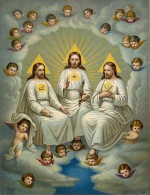William Branham and the Trinity Doctrine: Difference between revisions
No edit summary |
No edit summary |
||
| Line 9: | Line 9: | ||
<div style="float:left; width:194px; padding:.3em 0;margin:2px 2px 0; background-color:#cedff2">[[Q&A on the Godhead|Questions and Answers]]</div> | <div style="float:left; width:194px; padding:.3em 0;margin:2px 2px 0; background-color:#cedff2">[[Q&A on the Godhead|Questions and Answers]]</div> | ||
<div style="width:0;height:0;clear:both;overflow:hidden"></div> | <div style="width:0;height:0;clear:both;overflow:hidden"></div> | ||
</div> | </div> | ||
|} | |} | ||
{| style="width:800px" | |||
| The Trinity is an explaination of the [[The Godhead]] accepted by most of the world's Christian denominations. The word "Trinity" was first used circa. A.D. 200 by Tertullian, a Latin theologian from Carthage who later abandoned Christianity for Montanism. | |||
A basic definition of the Trinity would be as follows: | |||
:'''Within one Being that is God, there exists eternally three coequal and coeternal persons, namely the Father, the Son and the Holy Spirit.'''<ref>James White, The Forgotten Trinity, Bethany House Publishing, 1998</ref> | |||
Commonly referred to as "One God in Three Persons", the Father, Son and Holy Spirit are identified as distinct and co-eternal "persons" or "hypostases," who share a single Divine essence, being, or nature. | |||
The doctrine of the Trinity is the result of continuous exploration by theologians of scripture and philosophy, argued in debate and treatises. In 325 A.D. this doctrine was accepted by the Christian Bishops in attendance at the council of Nicea, under the watchful eye of the pagan Emperor, Constantine I. | |||
{{col-begin}} | |||
{{col-break}} | |||
{| style="width:150px;border:1px solid #E8B399;background-color:#F0DCC8;vertical-align:top; text-align:center;" | |||
|[[The Godhead|What is God? <br> (The Godhead)]] | |||
|- | |||
|} | |||
{{col-break}} | |||
{| style="width:150px;border:1px solid #E8B399;background-color:#F0DCC8;vertical-align:top; text-align:center;" | |||
|[[Trinity and Oneness|Trinity and Oneness doctrines vs. the Bible]] | |||
|- | |||
|} | |||
{{col-break}} | |||
{| style="width:150px;border:1px solid #E8B399;background-color:#F0DCC8;vertical-align:top; text-align:center;" | |||
|[[Portal:History (Eternity)|Who is God? <br> (A brief history)]] | |||
|- | |||
|} | |||
{{col-break}} | |||
{| style="width:150px;border:1px solid #E8B399;background-color:#F0DCC8;vertical-align:top; text-align:center;" | |||
|[[Jesus on the Godhead|Bible Studies on the Godhead]] | |||
|- | |||
|} | |||
{{col-end}} | |||
<div style="border-bottom:1px #B87333 solid; text-align:center; font-size:140%; padding:1px; margin:1px;">Problems with the doctrine of the Trinity</div> | <div style="border-bottom:1px #B87333 solid; text-align:center; font-size:140%; padding:1px; margin:1px;">Problems with the doctrine of the Trinity</div> | ||
[[Image:3people.jpg|thumb|150px|A misleading impression of the Trinity (by Fridolin Leiber) as "person" does not mean "individual".]] | [[Image:3people.jpg|thumb|150px|A misleading impression of the Trinity (by Fridolin Leiber) as "person" does not mean "individual".]] | ||
As evidence that the Catholic Church has not always believed the Trinity, the doctrine of Callixtus I, the Bishop of Rome (i.e., Pope) between 217 – 222 A.D. and a saint of the Roman Catholic Church, is recorded as follows: | As evidence that the Catholic Church has not always believed the Trinity, the doctrine of Callixtus I, the Bishop of Rome (i.e., Pope) between 217 – 222 A.D. and a saint of the Roman Catholic Church, is recorded as follows: | ||
Revision as of 02:32, 30 May 2013
|
- ↑ James White, The Forgotten Trinity, Bethany House Publishing, 1998
